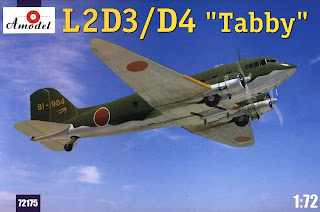Way back in September 2011 attention was drawn to the release by Amodel of two new kits of the "Japanese Dakota" - the L2D2 and L2D3/4 "Tabby" twin-engined transport 'plane. I still haven't seen these kits in person or come across a review or build, although there is presentation of the kit sprues here. Still, in the spirit of the pioneer and you never know this rambling discourse will offer some information on the interior colours of this type, FWIW and in the hope that someone, somewhere, might find it useful as they sit contemplating the kit parts and a fully scratch-built interior complete with transport load and passengers.
Meiktila ELG, Burma, July 1945
"Tabby 2-2 - After having seen nothing but Army types it was quite a pleasant change to find one more or less complete example of this Japanese development of the DC-3. Several changes between Tabby 2-2 and its allied counterpart were noticed. Rough notes are as follows:- Spinners ftted to the airscrew hubs of the Kinsei 51, 52 or 53 motors. Passenger door on port side. No hand rails. Interior layour changed a great deal from the Dakota II. Small lavatory on starboard side was much further forward and included a neat folding wash-basin. A drop flap on rear lavatory bulkhead disclosed a further compartment, presumably used for ballast (or perhaps personal baggage?).
"Entire interior colour scheme was fawn (light yellowish tan) and chromium. Walls were soundproofed. Both port and starboard sides deep metal luggage racks with chromium handrails extending the full length of the compartment. Electric lamp sockets were fitted every so often on the sides of the racks. Wooden floor. Pilot and second pilot sit side by side in normal fashion. Wireless operator and navigator behind pilots on port and starboard side respectively. No "solid" partition between pilot and wireless operator. Large hatch immediately above pilot's position. Small hatches above other two crew, both of which have extra side windows also. Entire cockpit very light. Compartment for luggage behind crew's section was approximately the same size and shape as the Nav, W/OP's on the Dakota C Mk. IV. This extra space, taken up at both ends by these extra compartments, makes passenger accommodation smaller. Seats and half floor had been removed so I could not judge the seating capacity. Small door with circular window immediately in front of radio operator on port side, Half of nose section swings upwards and outwards. Streamlined metal D/F egg with large radio mast behind is fixed on top of fuselage. Seven windows each side. Third up from tail on starboard side incorporated an emergency exit. On port side two similar emergency exits were located second and third up from the tail. Apart from the motors and minor details, the silhouette contained in THE AEROPLANE SPOTTER No.104 is correct for this version.
"Camouflage.- (a) Upper surfaces (including fin and rudder).- Matt light green.
(b) Under surfaces.- Polished metal finish merging into upper surface camouflage.
(c) Markings.- Red roundels with white surround on fuselage sides. Normal red disc above and below wings not overlapping ailerons. White band round rear of fuselage. White stripes on fin and rudder. Two large white Japanese characters on each side of nose. Three bladed metal airscrews were painted matt black with dull red spinners. Yellow leading edge from roots to mid way out on each wing. All interior metal work was painted light yellowish green."
With grateful thanks to LAC Morton 1/c and Charles W Cain, Editor of The Aeroplane Spotter who preserved the record of his valuable observations for future generations. More of these fascinating documents will feature in future blog posts here.
Image credits:- Box art © 2011 Amodel; Photos via Wiki




9 comments:
Thanks for posting this, Nick.
Regards,
Ken Glass
Would be nice to see this in 1/48 scale.
Nick,
Very interesting description of colors, thank you! I wonder what this interior tan color looked like, may be something similar to Tan (N38) as seen on some A6M3 interior remains?
Best regards,
Iskender
Hi Iskender,
Please bear in mind that this fawn colour would be mainly the fabric soundproofing inside the cabin. If it was anything like the interior of the civil Nell then probably something similar to FS 33717. The civil Nell had a dark reddish-brown carpet and sage green 'plush' covered seats of the type seen in old cinemas.
From the location I suspect that this might have been an ex-civil or military VIP Tabby requisitioned for freighting by the Army and with the seats stripped out.
Regards
Nick
Thanks, Nick. I haven't thought it was fabric, thanks for pointing this out. Information regarding civil Nell (L3Y) is also very helpful.
Best regards,
Iskender
Nick,
Thanks for posting these most interesting observations by LAC Morton. Long time ago I photographed these pages with a simple camera and, as I see it the best is yet to come. I was most impressed by what he wrote about the Gremlin T/F planes.
Jacob.
There is some pretty clear colour footage of one being shot down here:
http://tinyurl.com/apprda5
Ken, Jacob, you are welcome and yes, more to come!
Jerry, thanks for posting that interesting link.
Regards
Nick
That's an unusually detailed description for that period and the circumstances. Excellent info!
Post a Comment